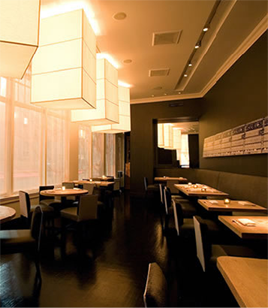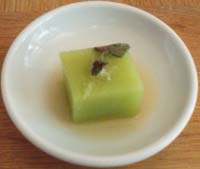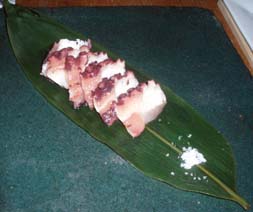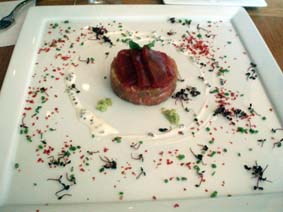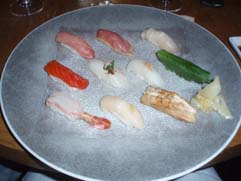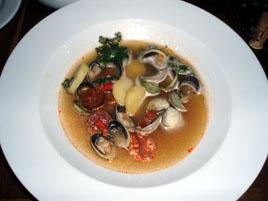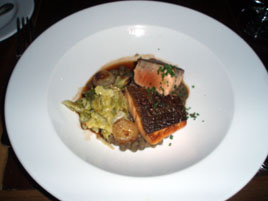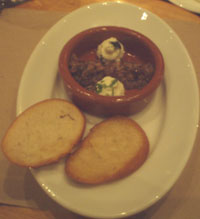
Note: In late 2015, Union Square Cafe closed at its original location, due to a rent hike. It is expected to re-open a few blocks away in spring 2016, in the former City Crab space.
*
 Has it really been 20 years since I visited Union Square Cafe? I’ve a vague memory of lunch there, about that long ago. It’s been on my revisit list since forever, but was never readily bookable at times I wanted to go.
Has it really been 20 years since I visited Union Square Cafe? I’ve a vague memory of lunch there, about that long ago. It’s been on my revisit list since forever, but was never readily bookable at times I wanted to go.
Reservations have loosened up a bit: recently, I was able to book midweek at 6:45pm on ten days’ notice. I don’t recall ever being able to do that.
You really do need to try Union Square Cafe. On any fair reckoning, it is one of the most influential New York restaurants of the last quarter-century. If it had accomplished nothing else, it would deserve a place in the pantheon for launching the career of restaurateur Danny Meyer, who was 27 when it opened in 1985.
There were stumbles then: a one-star review from Bryan Miller in 1986. Meyer persisted, replacing the opening chef (Ali Barker) with Michael Romano, winning three stars from Miller in 1989. By 1999, William Grimes re-affirmed three stars, noting that although the place was still “hugely popular…It’s not the food that’s setting off the stampede.”
When Union Square opened, it was one of the first, and the best, of a new breed that Bryan Miller called ”international bistro,” in reviewing the restaurant in 1989 in The New York Times and awarding it three stars.
Union Square has not changed, but the world has changed around it. Michael Romano, the executive chef and part owner, does what he has always done, and done very well, which is to turn out jazzed-up bistro and trattoria fare with utter consistency. What looked like a flashy sports car a decade ago now seems more like a midsize Buick cruising in the center lane at a precise 65.
Ten years later Frank Bruni knocked it down to two stars. There were too many blunders; the food wasn’t consistent enough. But he still found, as one does at every Danny Meyer restaurant, “staff so seemingly genuine in their yearning to accommodate you and their contrition when they can’t that Danny Meyer…must be giving them either Method acting classes or major pharmaceuticals. Maybe both.”
It would be foolish to expect Union Square Cafe to change very much. At some point, a pathbreaking restaurant becomes a tradition in itself. This restaurant has earned that.
It could still clean up its act. I don’t know many places that serve a $13.50 cocktail, with a straw still in its sealed paper sheath. A restaurant of this caliber shouldn’t be serving any accessory in its factory wrapper. When I ordered a glass of wine to follow up, the server failed to bring it, because she didn’t notice I’d finished that cocktail, even though considerable time went by.
We ordered two appetizers to share; only one came. Realizing their mistake, the staff served the second appetizer with the entrées. (To be fair, it was taken off the bill without prompting.)
 The cuisine is difficult to classify. The website calls it “American … with an Italian soul, using fresh ingredients from the local Greenmarket.” Miller’s first three-star review called it “Northern Italian” cusine, flat out.
The cuisine is difficult to classify. The website calls it “American … with an Italian soul, using fresh ingredients from the local Greenmarket.” Miller’s first three-star review called it “Northern Italian” cusine, flat out.
Over the years, the Italian influence has mellowed, aside from the pasta section of the menu. Most of the appetizers and main courses could be found in any seasonal American restaurant, though descriptive Italian words pop up here and there. In the service and ambiance, Union Square Cafe doesn’t resemble an Italian restaurant at all.
Prices are not expensive, for a restaurant that had three stars until quite recently. Snacks are $4–7, appetizers $10–19, pastas $16–19 (small portion) or $26–29 (large), entrées $27–35, side dishes $8–10. I’d call that the “upper middle” price range for Manhattan. The menu changes daily, and the website (every time I checked) displayed a current one.


Appetizers were weaker than the main courses. Asparagus Tempura ($19; above left) sounded like a good idea, but when you throw in lobster, seared pork belly, and ramp vinaigrette, it’s at least one ingredient too many. The asparagus were good, but the lobster was slightly rubbery, the pork belly a bit chalky.
From the snacks portion of the menu, we ordered the Pig Ears ($6; above right) as our second appetizer. This was the item that didn’t come out on time. I liked the tarragon mustard, but the ears themselves were in a cloying sauce that tasted like soy. We didn’t bother to finish them.


I was impressed with both entrées. Pork shoulder ($27; above left) was in a honey-balsamic glaze, with ramp polenta and spring slaw. I’m not positive what accompanied the Trout ($27; above right), as the online menu has since changed, but the fish itself was lovely.
The beverage list runs to 33 pages; wines are mostly French, Italian, and American, priced from the mid-$40s to the thousands. There is something here for almost every budget.
The attractive tri-level space would be considered a bit old-fashioned if it opened today, but I doubt there are any complaints from the clientele, which skews slightly older than average. There is a younger crowd at the bar, where a full menu is available. The décor deftly straddles the line between formal and casual. Whether it’s a special occasion or an average night out, you can feel at home.
The service, so eager to please, fumbles at times — or did on this particular night — but Union Square Cafe remains worthwhile, and could still teach its many imitators a thing or two.
Union Square Cafe (21 E. 16th St. between Broadway & Fifth Ave., Union Square)
Food: American Greenmarket with Italian influences, mostly very good
Service: As accommodating as can be, if a bit sloppy at times
Ambiance: A civilized, adult restaurant; would that there were more of them.
Rating: ★★
Why? Still one of the best of its kind, after all these years
 Monday, April 20, 2015 at 01:10PM
Monday, April 20, 2015 at 01:10PM 
 Tex–Mex cuisine has always had a lowbrow reputation outside of its home territory, much as barbecue did a generation ago. You could visit these places for fun and sustenance, but the cooking was never taken seriously.
Tex–Mex cuisine has always had a lowbrow reputation outside of its home territory, much as barbecue did a generation ago. You could visit these places for fun and sustenance, but the cooking was never taken seriously. The restaurant is named for a kind of wild pig that roams the wilds of Texas. A stuffed specimen is on display above the bar, and you can see from its sharp teeth that this isn’t an animal to be toyed with.
The restaurant is named for a kind of wild pig that roams the wilds of Texas. A stuffed specimen is on display above the bar, and you can see from its sharp teeth that this isn’t an animal to be toyed with.









































